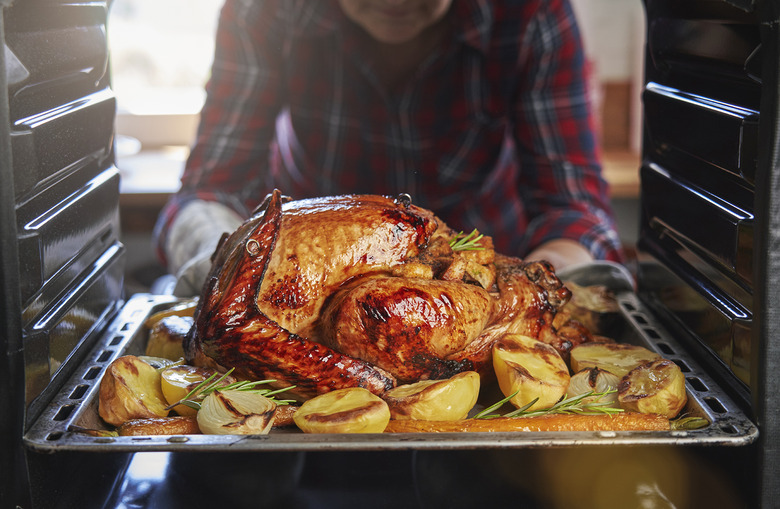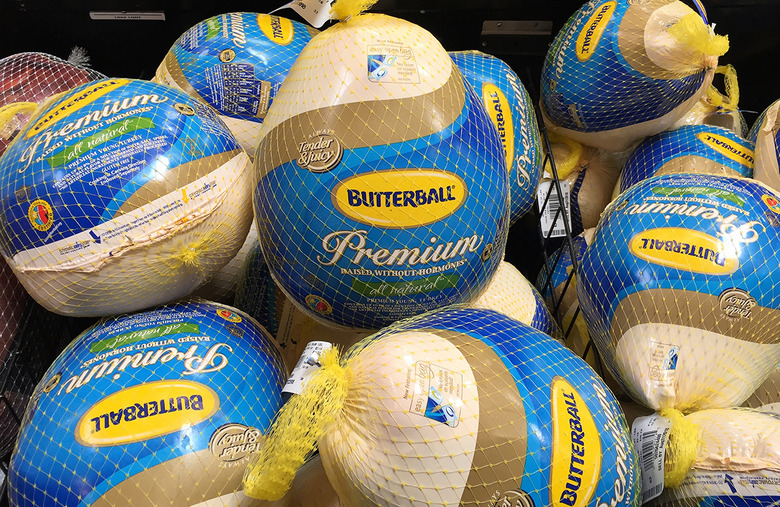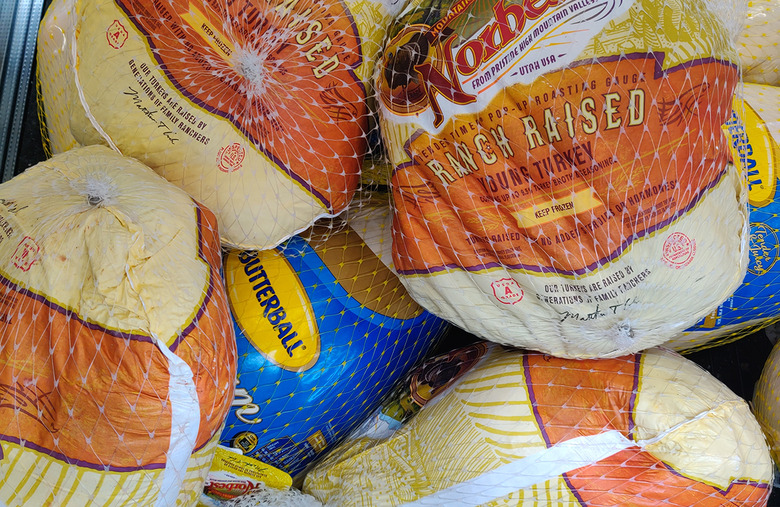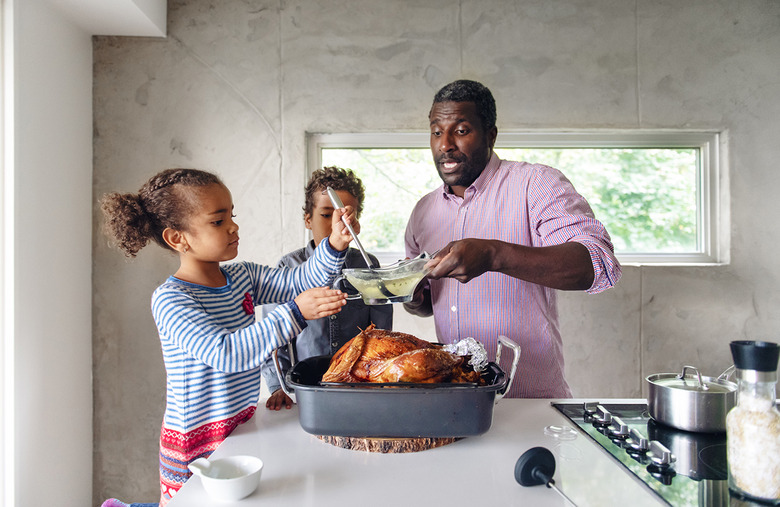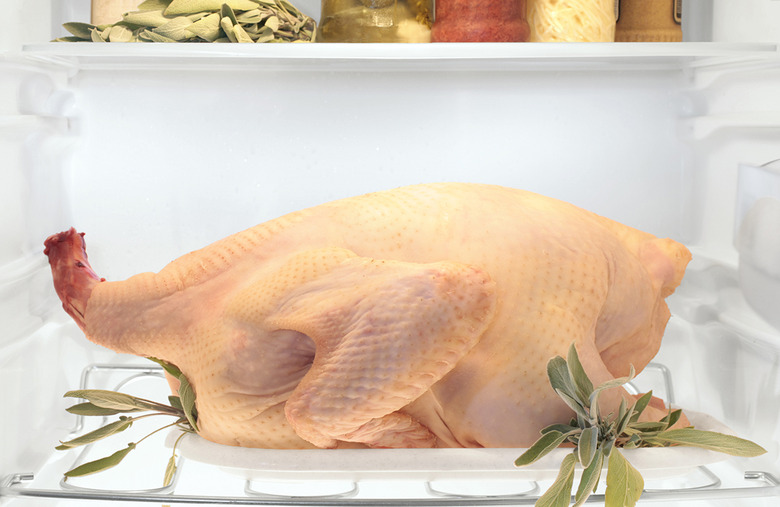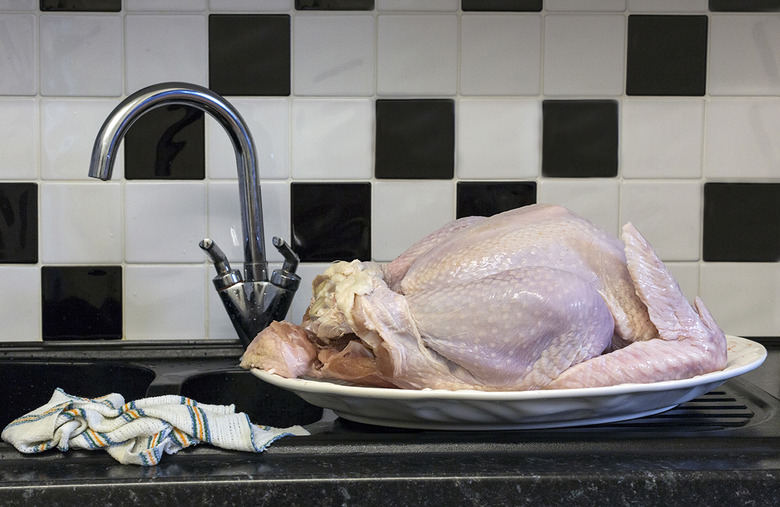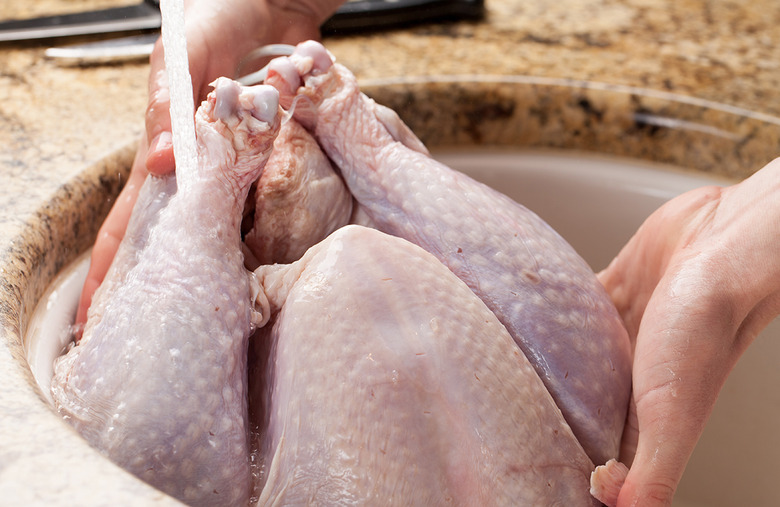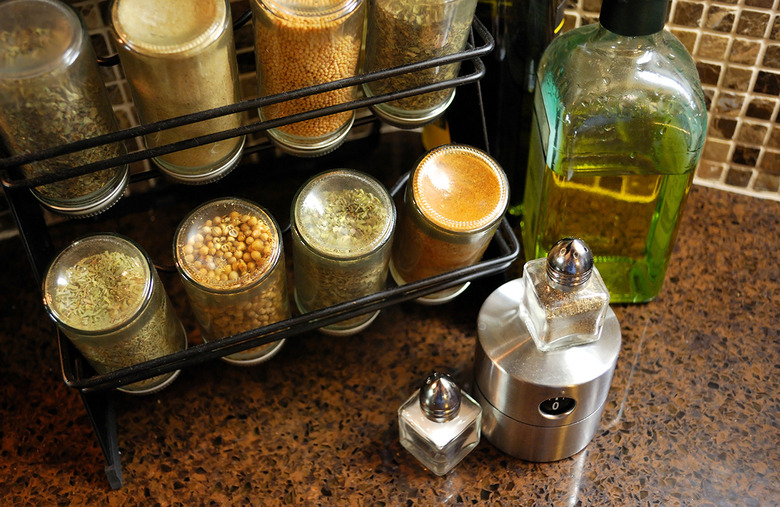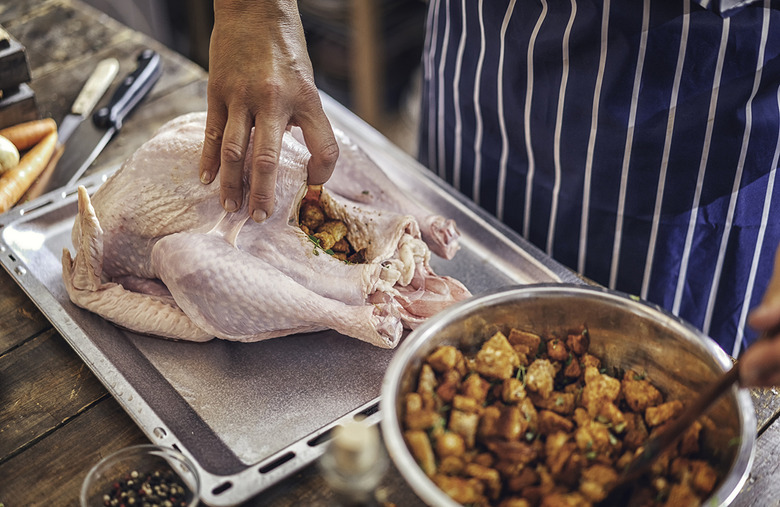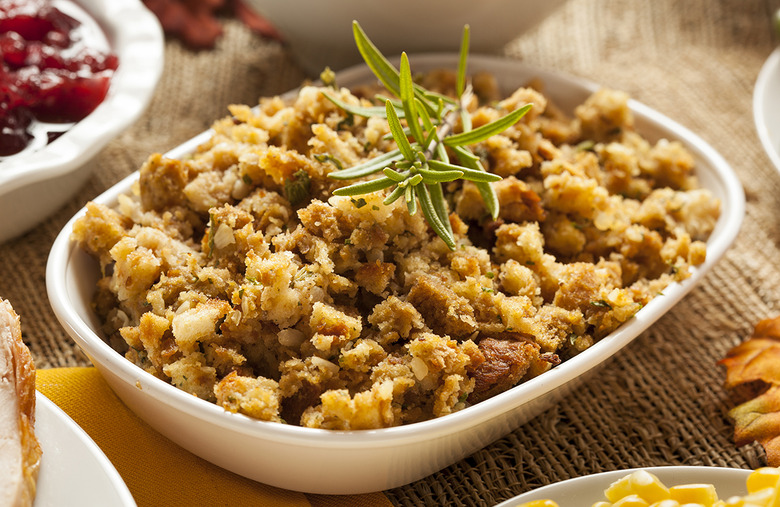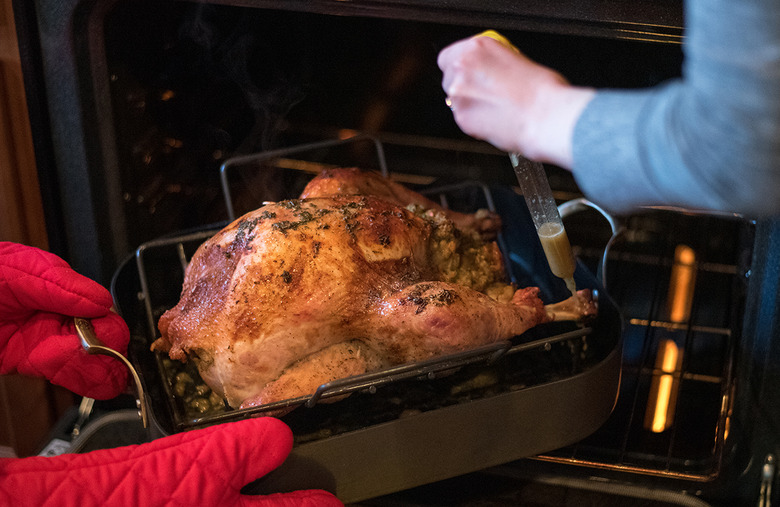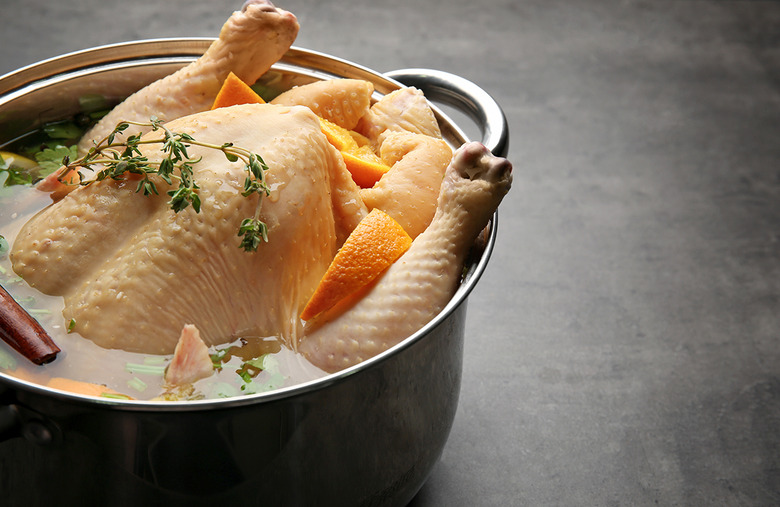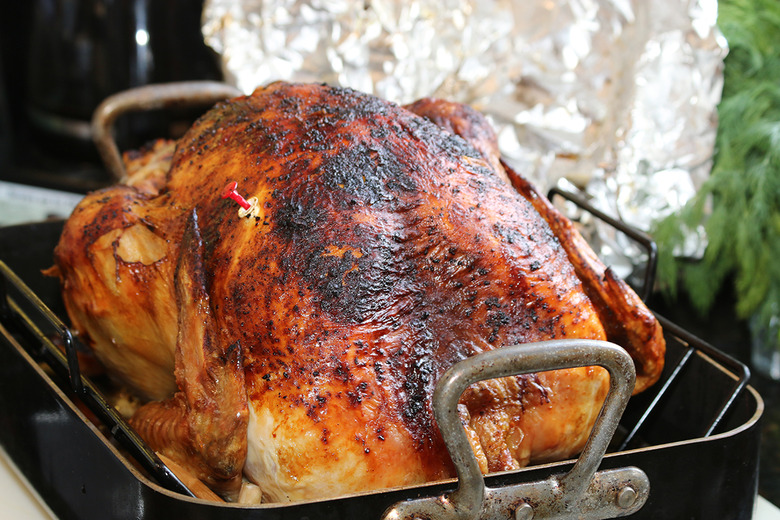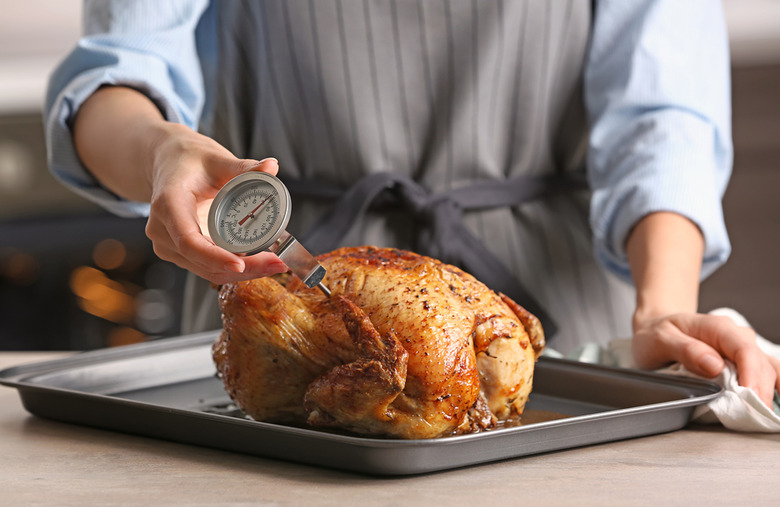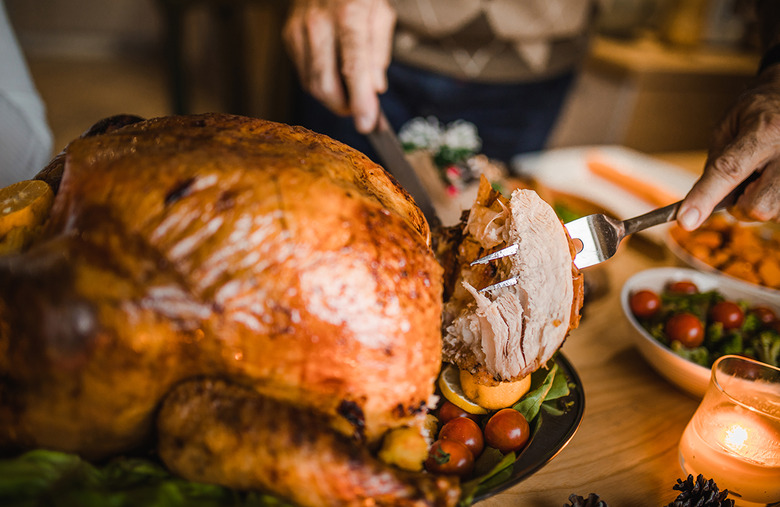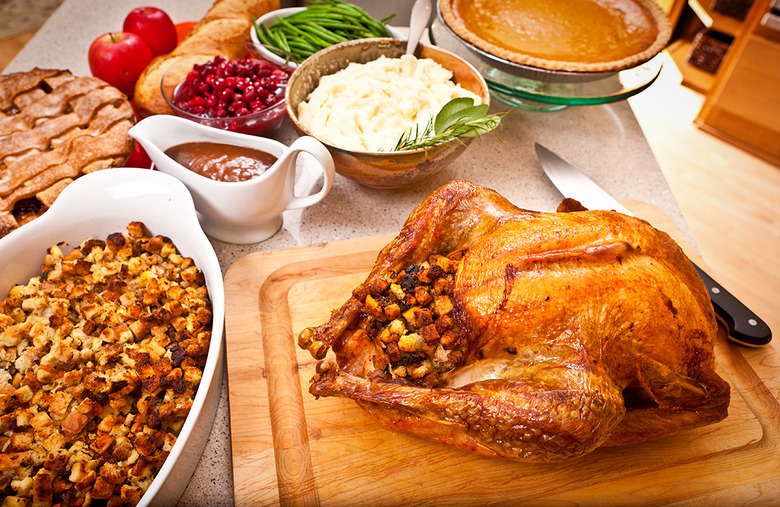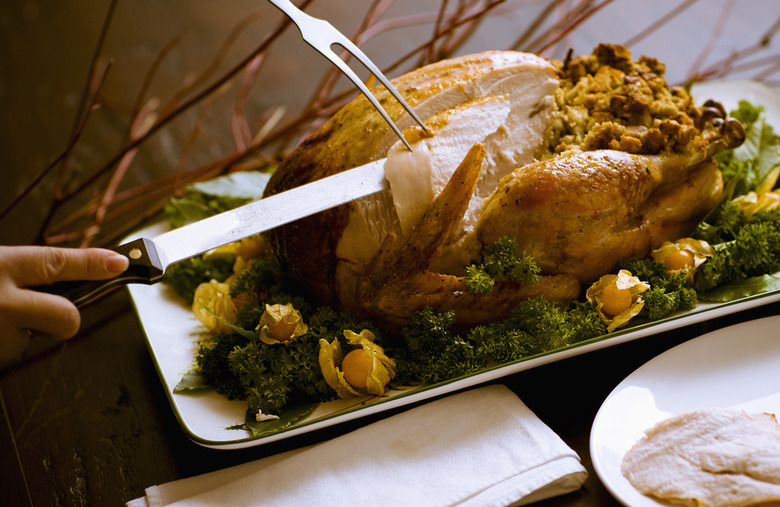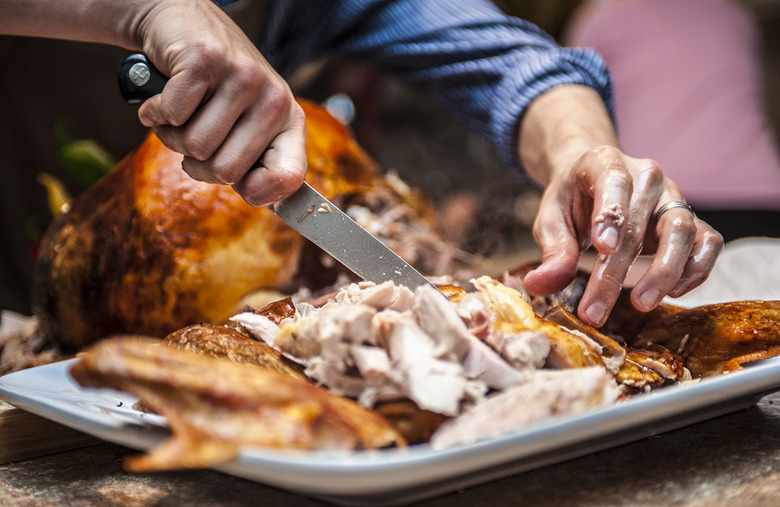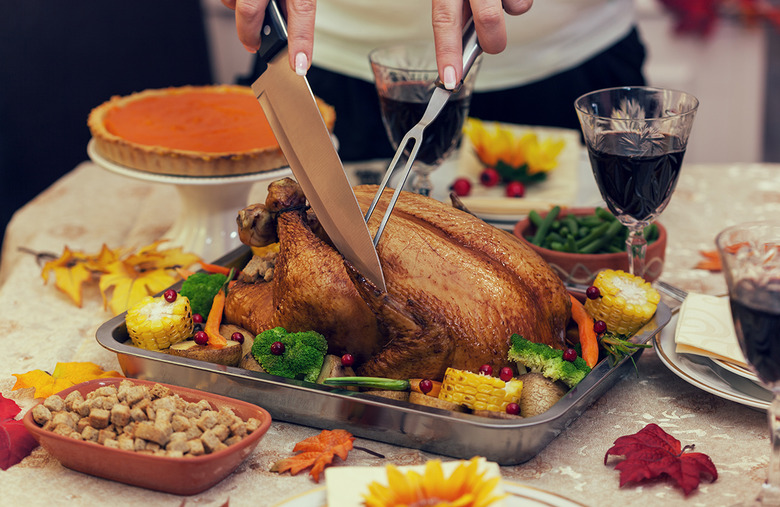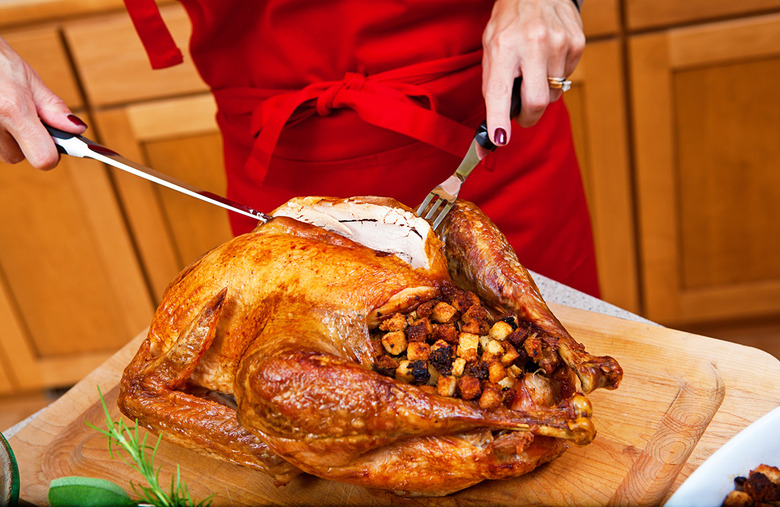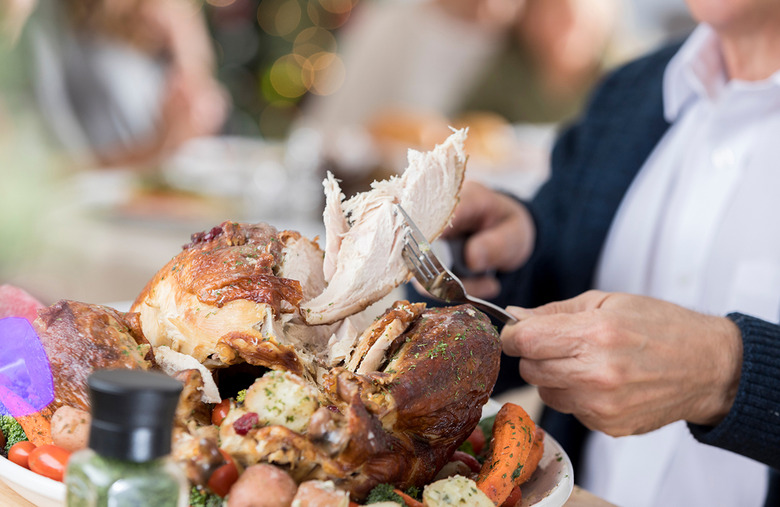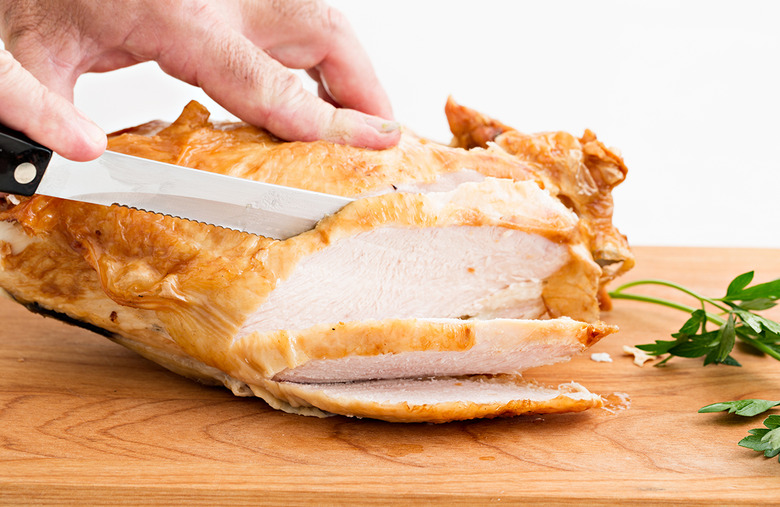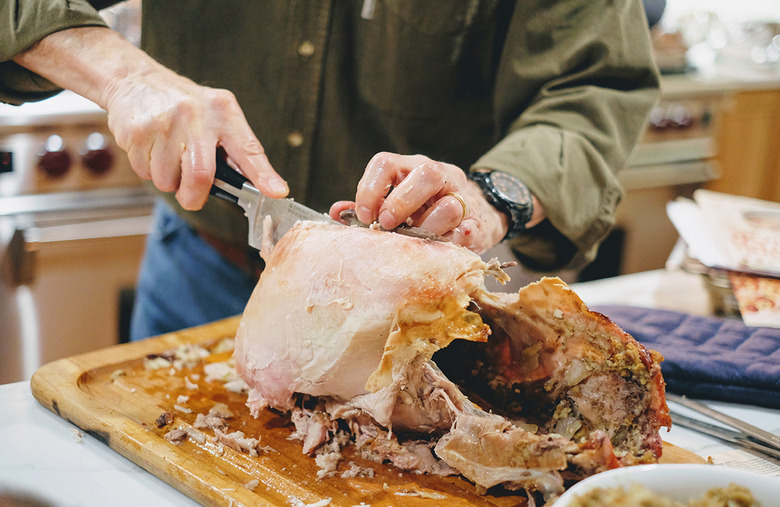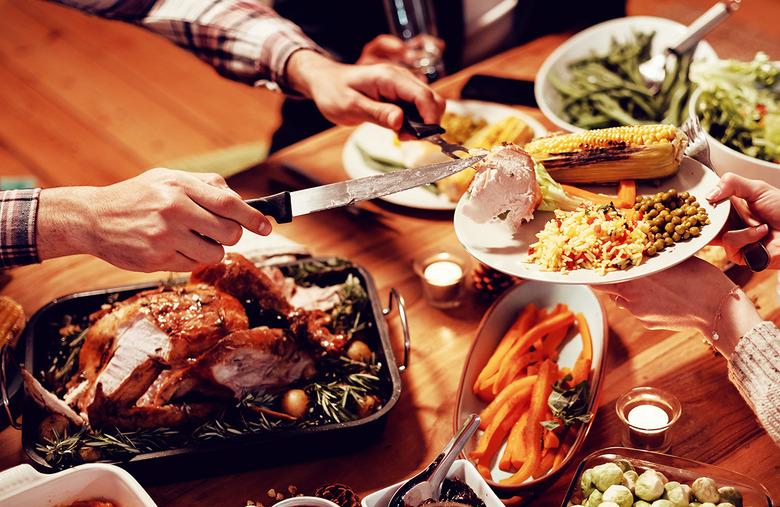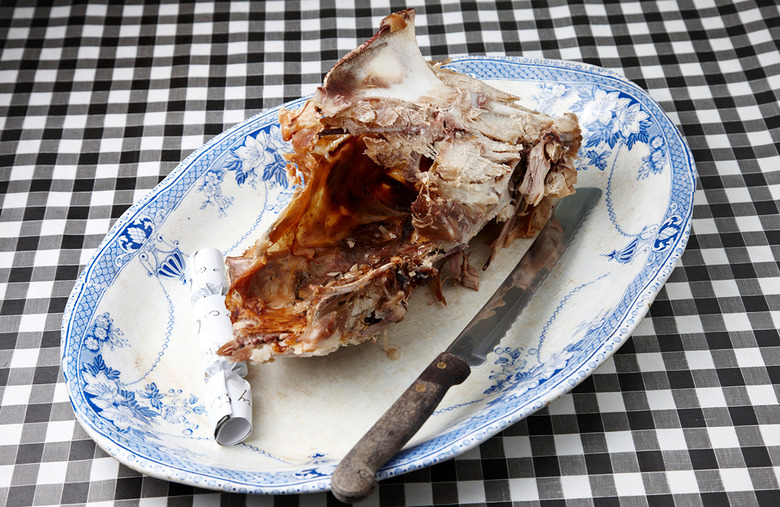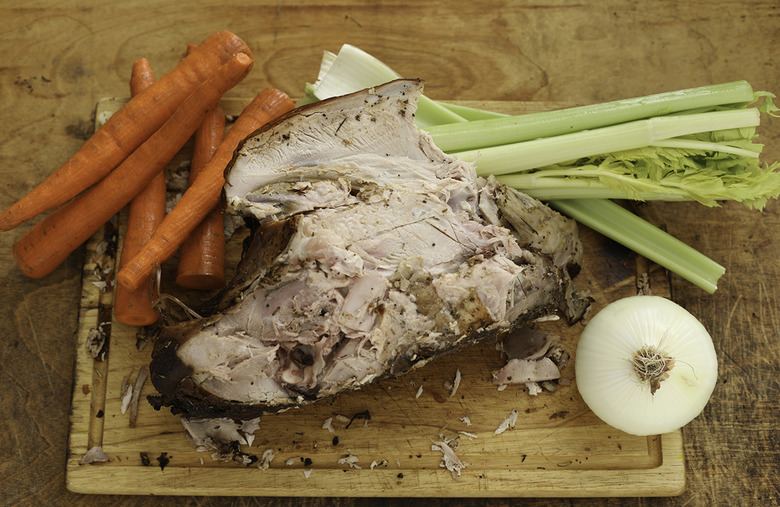How To Cook Turkey And Carve It Correctly
Turkey is an integral part of holiday dinners, but most people only make this big bird once or twice a year. It can be easy to forget exactly how to pick and roast the perfect turkey, and it's even easier to walk right into common turkey buying, roasting and carving mistakes. Luckily, you can avoid holiday blunders by knowing what these turkey faux pas are and how you can avoid them.
Mistake: You buy the wrong size turkey
Frozen whole turkeys can range from about 10 to 32 pounds, so it can be hard to know what size turkey you need when you walk up to the poultry section at your grocery store. Buying too small of a bird means your guests may go home hungry, and buying too big of a bird will be a waste of money that could lead to spoiled leftovers.
Fix: What size turkey to buy
How much turkey should you buy per person? Go for at least 1 pound per guest. While that amount far exceeds the standard 4-ounce meat serving at most meals, it accounts for bone and giblet weight. If you want to send everyone home with lots of leftovers, buy at least 1 1/2 pounds per guest. That means a party of eight requires a 12-pound turkey or larger.
Mistake: You don’t have the right tools to roast a turkey
One of the biggest kitchen tool questions is: What do you need to roast a turkey? You can't just put a turkey on a sheet pan or a standard casserole dish and expect crisp skin and tender meat. Roasting the perfect turkey requires special tools that novice cooks may not already have in their kitchens.
Fix: What you need to roast a turkey
Don't just plan to pick up your Thanksgiving groceries — get your cooking gear before Turkey Day too. At the very least, you need a roasting pan with a nonstick rack for your turkey. If you don't want to invest in a giant pan just for one day of the year, a foil roasting pan can get the job done. Just make sure that it is sturdy and free of holes. An instant-read probe thermometer is the best way to tell that your turkey is done, so get one of those as well. Other useful tools include twine to truss your bird, a large cutting board, kitchen shears and a sharp carving knife.
Mistake: The turkey is still frozen right before Thanksgiving
Thawing a turkey is an easy process, but the preferred method is a lengthy one that can take about a week. To defrost a bird in the refrigerator takes planning. Remove your turkey from the freezer but keep it in its wrapper. Place a sheet pan with high sides on the bottom shelf of your fridge and place the turkey, breast-side up, on the sheet pan. Your turkey needs one day in the refrigerator for every 4 pounds, so a 16-pound bird will need four days. Just don't count the cooking day in your defrost time. If you're making that 16-pound turkey on Thanksgiving Day, start the defrosting process on Sunday. Your turkey will be safe in the fridge for two days after it's been thawed, so don't be afraid to start the defrosting process a little early.
Fix: How to thaw your turkey in water
If you have forgotten to do a fridge defrost for your turkey, it isn't too late to save Thanksgiving. It is possible to do a cold-water defrost. To properly perform this method, remove your turkey from the freezer and keep it in the wrapper. Also ensure it's in a leak-proof bag to prevent cross-contamination or the turkey from absorbing water. Fill your sink, bathtub or a cooler with cold water and completely submerge your bird, breast-side down, in the cold water. Change the water every half hour, keeping the water at about 40 degrees. For every 1 pound of turkey, you need to keep your turkey submerged underwater for 30 minutes. That 16-pound turkey will need eight hours to defrost. No matter what you do, don't defrost your turkey in the microwave or at room temperature.
Mistake: You rinse your turkey
Some people will rinse their turkey, chicken or other meat to try to wash away any bacteria. However, this practice will turn your kitchen into a biohazard zone. The raw juices can splash and spread bacteria all over your kitchen counter and workspace.
Fix: How to kill bacteria on your turkey
Cooking the meat to temperature is generally all you need to do to kill any present bacteria. Make sure the meat is cooked to 165 degrees measured on a meat thermometer. What you should do to prep your turkey for the oven is pat the inside and outside down with paper towels to ensure you get crispy skin as it roasts.
Mistake: You don’t season your turkey correctly
Turkey has a reputation for being bland, but that's just because people don't know how to season this meat correctly. One of the top tips for cooking all kinds of meat correctly is to not just brush the outside with a little oil and a sprinkle of salt and pepper before putting it in the oven.
Fix: How to season turkey
Follow a simple-yet-herbaceous turkey recipe. The best way to avoid a bland bird is to remember the inside of your turkey. After you pat the outside and cavity of the bird with paper towels, season the entire thing liberally with salt and pepper, including the cavity. Then stuff the cavity loosely with aromatics such as garlic, onion, lemon, thyme and other herbs. Brush the outside of your turkey with a thyme-infused butter, and you'll have a well-seasoned main course.
Mistake: You put stuffing inside the turkey
Stuffing a turkey may be the traditional way to make your Thanksgiving dinner, but the FDA advises cooking your stuffing separately from your bird to avoid cross-contamination.
Fix: How to cook stuffing
Make your stuffing in a separate casserole dish on the side. Not only is this more food-safe, but it also leads to a better-flavored turkey and stuffing with a perfectly crisp exterior and a moist interior. If you insist on cooking your stuffing inside the bird, be sure that the center of the stuffing reaches a food-safe temperature of 165 degrees. However, this can lead to dry meat.
Mistake: You baste your turkey
Did you ever wonder why the turkey that was supposed to be ready in three hours is taking all day? It may be because you're basting the bird. Every time you open your oven, you lose heat, meaning your turkey will take longer to cook.
Fix: How to add flavor to turkey
Basting your turkey is one of those cooking habits you need to stop now. While it's believed that basting your turkey leads to juicier meat, basting actually causes heat to escape the oven and leads to longer cooking times and a dried-out turkey. To flavor your turkey, consider a brine instead.
Mistake: You use a pop-up timer
Most grocery store turkeys come with a handy little plastic pop-up timer in the breast that springs to life when your bird is done roasting. But there's a reason why turkey has a reputation for being dry, and it's because these pop-up timers are wildly inaccurate.
Fix: How to know your turkey is done
One of the most common turkey cooking questions is how to know when your turkey is done. Well, you can't tell when it's done by a pop-up timer or the color of the skin. The only way to tell if your turkey is done is when it has reached an internal temperature of 165 degrees.
Mistake: You check the temperature in the wrong place
If you make a lot of chicken recipes, you know that a whole roast chicken needs to come to 165 degrees at the innermost part of the thigh and the thickest part of the breast. A turkey works the same way.
Fix: How to check the temperature of your turkey
Knowing how to check food temperatures is one of those cooking skills your grandma had. Channel her energy. You should feel some resistance when you check the temperature. If the thermometer moves easily, you have pierced into the cavity; if you feel something solid, you have hit bone.
Mistake: You don’t allow your turkey to rest after roasting
Anyone who cooks steaks perfectly knows that resting your meat before cutting into it is an integral part of the cooking process. The same goes for turkey. Not only is a turkey piping hot when it first comes out of the oven, but the juices also have not had time to redistribute. Carving your bird the second it comes out of the oven means all those tasty juices will spill out of the bird and onto your carving board.
Fix: How to let turkey rest
Loosely tent your bird with foil and allow it to rest for about 20 minutes after it comes out of the oven. If you need the oven to warm up your side dishes, you can let the turkey rest for up to an hour.
Mistake: You use a carving fork
Whether you prefer white meat or dark meat, you need to carve your turkey before serving. While a carving fork can be useful for serving a turkey, don't use it to steady your turkey as you carve it.
Fix: How to steady a turkey
A cooking tip we learned from our parents? Use a towel to protect your hand from the hot turkey when you cut instead.
Mistake: You remove the wings first
Many people will start their carving by removing the wings first to get them out of the way before they start carving the breast meat. But this is one of the many carving mistakes you're making.
Fix: When to remove the wings
Keep the wings on your turkey until you remove the turkey breasts from the carcass. The wings help stabilize the bird while you remove the breast meat.
Mistake: You slice the breast meat incorrectly
Whether you want to eat your turkey breast on Thanksgiving or save it for some epic leftover sandwiches, you want to make sure you don't totally shred this precious meat. First, people will not remove the breast meat from the bone before carving. Second, it's common for people to cut against the grain, which leads to shredded meat.
Fix: How to slice breast meat
To carve a turkey breast correctly, first remove the breast from the bone, carving as close to the carcass as possible. To avoid shredding your meat, cut across the grain, straight down. This will lead to picturesque, even medallions.
Mistake: You carve more than you need
If you're carving turkey for dinner, you may as well carve the whole thing, right? Wrong. The meat will dry out faster once it's cut and will cool down quickly once it's placed on a platter. While it won't affect how long your Thanksgiving leftovers last, nobody likes dry turkey.
Fix: How much turkey to carve
Just carve the amount of turkey you will realistically eat for dinner (and maybe a tad bit more). Save the rest on the bone to carve later and use for some scrumptious leftover recipes.
Mistake: You throw away the turkey carcass
Don't pitch those turkey bones. Carcasses are an integral ingredient in making a delicious homemade stock.
Fix: How to store leftovers
When you've finished dinner and are putting away your Thanksgiving leftovers, use the carcass right away to make a comforting soup. If that feels like too much of a task right after you've already cooked a massive meal, feel free to store the turkey bones in the freezer until you are ready to use them. And chances are you'll want to reuse them and all your leftovers after cooking up a storm with our 101 best Thanksgiving recipes.
More from The Daily Meal:
Thanksgiving Dishes You Can Make Ahead and Freeze
Facts You Didn't Know About Macy's Thanksgiving Day Parade
10 Thanksgiving Dishes You Should Just Buy at the Store
How to Cut Your Thanksgiving Grocery Bill in Half
10 Things Southerners Always Have on Their Thanksgiving Table
